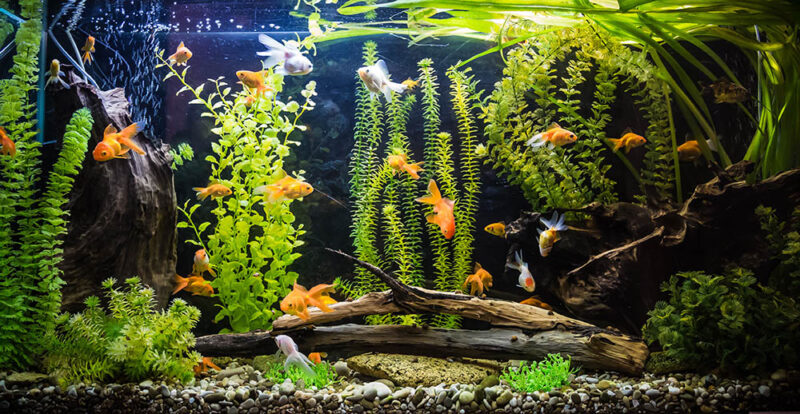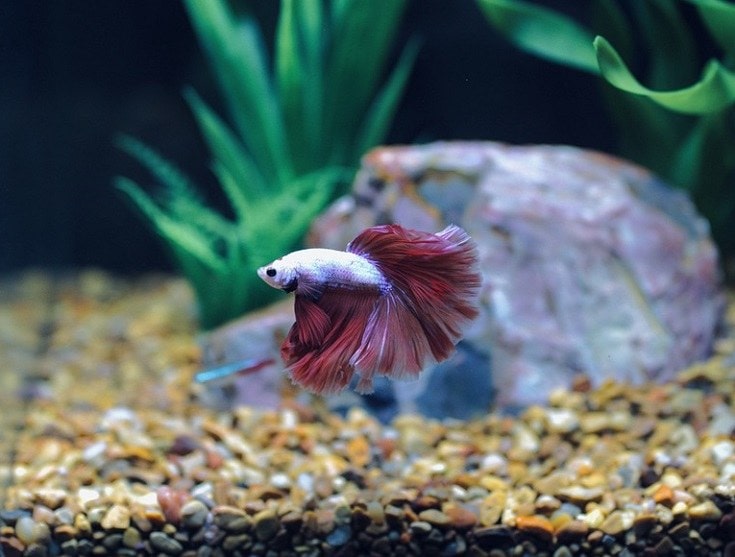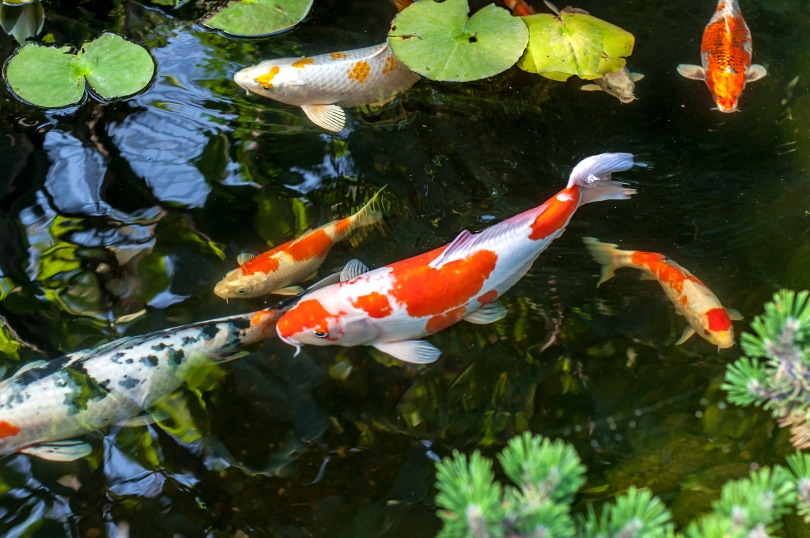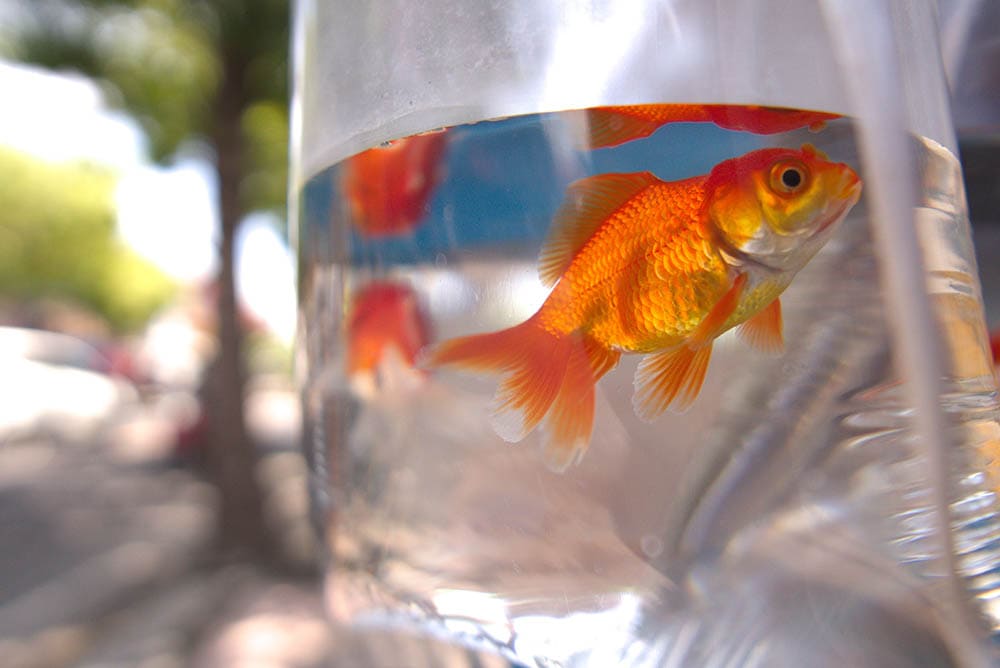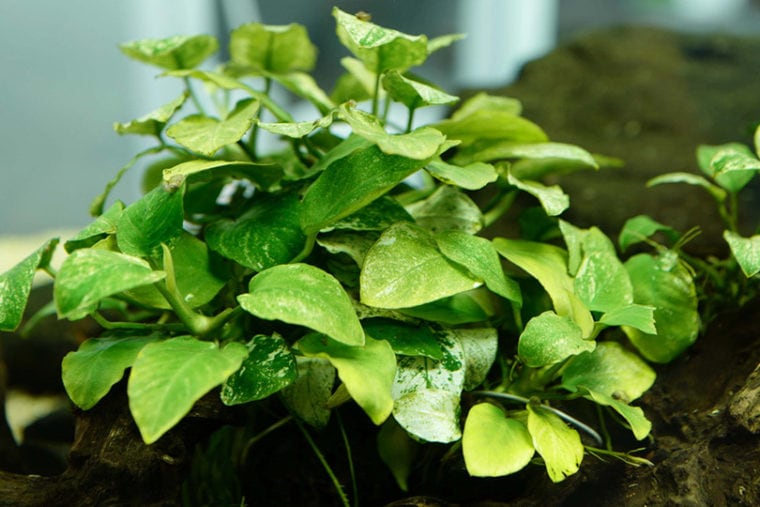
The Anubias is a beginner’s favorite because it’s easy to care for and doesn’t require much maintenance, besides benefitting from an occasional trim. These hardy plants can be found in the rivers and streams of central and western Africa—and there are many different types of Anubias to choose from, with some being small and others larger. A few varieties are Anubias nana, Anubias gigantea, Anubias barteri, and Anubias heterophylla.
You can grow Anubias at the surface of the water with its leaves sticking out, or underneath it. However, when completely submerged underwater while in direct sunlight, it’s prone to developing algae on its leaves. You want to avoid any hindrances to the development of this plant as it grows very slowly, with about one new leaf a month. Low to moderate light is all this plant needs to grow and stay algae-free.
These plants may have caught your attention at the fish store or a friend’s house. If you have any hesitation about adding them to your tank, we’re here to help you ease any concerns.
| Family Name: | Araceae |
| Common Name: | Anubias |
| Origin: | Central and western Africa |
| Color: | Green |
| Size: | 7.5 inches |
| Growth Rate: | Slow |
| Care Level: | Easy |
| Lighting: | Low-moderate |
| Water Conditions: | 72–82ºF; pH 6–7.5 |
| Minimum Tank Size: | 10 gallons |
| Supplements: | None |
| Placement: | Foreground, midground, and background with driftwood or rocks |
| Propagation: | Rhizome division |
| Compatibility: | Tropical freshwater tanks |
Anubias Appearance
The Anubias has large, thick, waxy, green leaves—a perfect paradise for your fish to swim through and hide in. Some types of Anubias plants, such as the Anubias Nana, have smaller leaves, while the Anubias Afzelii has leaves that can grow as large as 12 inches. The shape, size, and color of the leaves vary from one Anubias plant type to the other. The type of Anubias you choose will depend on the size of your tank.
Anubias aren’t only desired for their big, green leaves but also for their attractive flowers that display colors of yellow or white when they bloom every few months. The flowers only last a few months, so make sure you show them off while they’re in full bloom. The flowers can survive outside the water or when submerged. If you love Lilies, you’re going to love the Anubias flowers!
Anubias are rhizome plants, another aspect that makes these plants so easy to maintain and grow. The leaves and roots come from the rhizome, with the leaves growing up and the roots, downwards, attaching to rocks and driftwood.

Where to Find It?
Although Anubias plants grow naturally in Africa, they are wildly popular, which makes them very accessible. You’re likely to come across several types of Anubias at just about any fish/pet store, whether large or small. Thankfully, they’re affordable too.
Varieties of these plants can be bought online but should be shipped to you quickly at a controlled temperature so as not to suffer during the trip. Make sure to quarantine your Anubias plant for 2 weeks before adding it to your fish tank to avoid contaminating your tank with diseases. Don’t neglect your Anubias plant in the process—you’ll still need to provide it with the correct lighting, heating, and filtration system during those 2 weeks of quarantine.
General Care
With so many Anubias varieties, there is little difference between their care needs, with all of them being hardy and easy to maintain due to this species being a slow-growing one. However, when your Anubias plant isn’t doing well, you’ll know from its leaves. Light-colored leaves with brown patches on them indicate that your plant isn’t healthy and needs some extra care.
Cleaning the tank every few weeks is vital for the health of your Anubias, along with the other forms of life housed in your tank. Dirty water will block the light from adequately reaching your plant, preventing photosynthesis. Cleaning the water will let the light in and prevent any pollutant buildup, maintaining nitrate levels.
Anubias cannot have its rhizome buried as it’ll cause the plant to suffocate. These plants can come potted. Otherwise, you can attach it to rocks or driftwood until it eventually secures itself to pieces in your tank.
To propagate the Anubias, split the rhizome into two halves. These halves will heal and grow into new Anubias plants.
Although many plants require fertilizers to provide them with the nutrients they need for growth, Anubias plants, being slow-growers, should be getting all the nutrients they need from the fish waste in the water. If your plant is showing signs of deficiency, you can add a light fertilizer. Make sure not to overdo it, though, as it can cause algae buildup in the tank.

Habitat, Tank Conditions & Setup
Tank/aquarium size
With so many varieties, you can find one of these Anubias plant types for almost any tank size. However, the minimum tank size should be around 10 gallons, which will be best suited for the smallest Anubias, the Anubias nana. The larger your Anubias, the larger your tank size should be. Most Anubias types need to be planted a few inches apart at a depth of around 12 inches of water to truly benefit from the nutrients it offers.
Water temp & pH
Anubias come from the tropical waters of Africa and need those same warm conditions in their tank to thrive. A comfortable water temperature for these plants is between 72–82 °F with a pH level of 6.0–7.5, but they can survive at higher and lower pH levels too. Anubias can grow in both standing and running water, although they prefer running water.
Substrate
Anubias plants get most of the nutrients they need from the water they live in, as well as the sun, and don’t require a substrate. They grow well when secured to rocks, driftwood, and other elements in the tank or pond. The substrate can help secure the plant, however, the rhizome should never be buried under it.
Plants
Anubias plants are happy to share their environment with any other aquarium plant as long as there is enough space and resources to go around. If you submerge your Anubias, you can add floating plants to the empty space above it, which will provide more shade.

Lighting
Anubias plants are found naturally in shaded rivers and will thrive in both low to moderate-light tank conditions. Letting too much light in will cause algae to grow on their leaves which will end up robbing the plant and harming it.
Filtration
Filtration isn’t necessary for an Anubias plant to thrive. However, they can also do well in tanks that have them if they’re secured to rocks or other items in the tank.
Planting Tips
You should never secure an Anubias plant by burying its rhizome as it’ll suffocate and die. However, these plants cannot be left floating around the tank either. You can secure Anubias plants down onto rocks and driftwood until their roots attach naturally by using plant-safe super glue, plant weights, or fishing line.
You can plant the Anubias plant completely submerged under the water, or on the surface of the water, with its leaves sticking out of the surface.
To have the best results out of all of the Anubias plants in your tanks, make sure they’re a couple of inches away from each other. Otherwise, they may suck up all the nutrients, leaving their closest companion to die. These plants may enjoy shaded areas, but they still need light to photosynthesize. Make sure they’ve got enough light reaching them without any large objects in the way.
Depending on how tall your Anubias plant species is will determine your placement. Shorter plants will do well near the front or middle of the tank, while tall Anubias plants should be placed at the back to not block the view of the rest of the tank and its occupants.

The 4 Benefits of Having Anubias in Your Aquarium
1. Provides oxygen and helps with filtration
Anubias plants help with filtration by absorbing fish waste and decaying matter while oxygenating the water. These plants make a big difference in a tank’s habitat and make the water more breathable. Although they may help you out, you still need to change the water regularly.
2. Provides shelter
Fish have many predators in the wild and may still feel the need to hide in tanks. The shelter can protect young fish that are small and can easily be swallowed by bigger fish. Adding big plants to hide in replicates the natural environment of a fish, and Anubias plants can provide fish with rest, protection from the light/sun, enjoyment through exploring, and privacy.
3. They’re hardy
One of the greatest benefits of Anubias plants is that they are hardy, making them an excellent beginner plant for fish tanks or ponds. These plants are strong enough to bounce back from most mistakes that could be made by first-timers without enduring too much harm.
4. They thrive where other plants don’t
They can survive in most setups that other more sensitive plants may not survive in. They’re also not tasty or soft enough for fish to nibble on, making them the perfect plant for tanks that contain fish that like to munch and destroy plants while doing so.
Concerns About Anubias
There isn’t much concern regarding Anubias plants due to the many benefits they bring, along with their low maintenance requirements. However, they do attract algae because of their large leaves and slow growth rate. High levels of light will speed up the growth of algae on their leaves, so be sure to keep the conditions at low to moderate light.
Final Thoughts
If you’re new to the Anubias plant world, it’s important for you to learn how to properly take care of one. Thankfully, it’s one of the easiest plants to care for.
Remember to keep it in water temperatures of 72–82°F, with low to moderate light conditions, and well-spaced from the other plants that share its environment. Give these plants the space they require by housing them in ponds or tanks that are no smaller than 10 gallons.
The Anubias plant is excellent for both beginner and experienced fish enthusiasts.
Featured Image Credit: Pavaphon Supanantananont, Shutterstock


